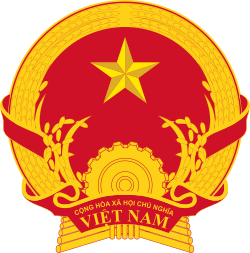Standing Committee of the National Assembly
The Standing Committee of the National Assembly, formerly known as the Council of State, is the highest standing body of the National Assembly of Vietnam. Its members are elected from among National Assembly deputies. Between 1980 and 1992, the Standing Committee served as the collective head of state, as the office of President was abolished.
 |
|---|
| This article is part of a series on the politics and government of Vietnam |
|
Ideology |
|
|
|
Legislative
|
|
Presidency
|
|
Executive
|
|
|
Military
|
|
|
See also
|
|
|
Council of State (1980–1992)
The Council of State was "responsible and accountable" to the National Assembly, according to Chapter VII of the 1980 Constitution. It played a more active role than the presidency it replaced, and, in addition, it assumed the day-to-day duties of the former Standing Committee of the National Assembly under the old constitution. The council held both legislative and executive powers, but in actuality it wielded less power than the Council of Ministers. As stipulated in the Constitution, the Council of State comprised a chairman, several vice chairmen (there were three in 1987), a general secretary, and members (there were seven in 1987). Members of the Council of State could not be concurrently members of the Council of Ministers. Its chairman concurrently commanded the armed forces and chaired the National Defense Council, which controlled the armed forces. The Council of State nominally presided over the election of deputies to the National Assembly; promulgated laws and issued decrees; supervised the work of the Council of Ministers, the Supreme People's Court of Vietnam, the procurator general of the Supreme People's Organ of Control, and the People's Councils at all levels; it decided, when the National Assembly is not in session, to form or dissolve ministries and state committees and to appoint or dismiss the vice chairmen of the Council of Ministers, ministers, and heads of state committees; it could declare a state of war, and order general or local mobilisation in the event of invasion. Such decisions, however, needed to be submitted to the next session of the National Assembly for ratification. The five-year term of the Council corresponds with that of the National Assembly, but the Council continued its functions until the new National Assembly elected a new Council of State.
However, this collective arrangement proved unwieldy, and in 1992, a new constitution was passed, reforming the Executive in the opposite direction: The office of President was reinstated, the Council of State reverted to being the Standing Committee of the National Assembly, and the Council of Ministers - itself also a collective body - was replaced with a cabinet, headed by a Prime Minister with wide amount of control over the executive.[1]
References
- Harrington, Joanna. "CONSTITUTIONAL REVISION IN VIETNAM: RENOVATION BUT NO REVOLUTION" (PDF). University of Victoria. Retrieved 12 December 2018.
